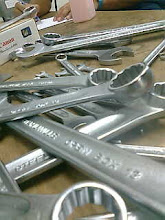By the turn of the century, in 1901, motorcycles were being manufactured for sale in several European countries. Most early models were either tricycles or based on bicycles - often made by bicycle firms. With only a few automobile manufacturers making cars, and the extra expense of a four-wheeler, motorcycles rapidly gained popularity, even among women who were enjoying the new political and social freedoms of the era. By 1913, there were 100,000 bikes registered in Britain.
Experimentation and innovation drove development right into the First World War. The new sport of motorcycle racing was a powerful incentive to produce tough, fast, reliable machines. These enhancements soon found their way to the public’s machines. By 1914, motorcycles were no longer bicycles with engines: they had their own technologies, although many still maintained bicycle elements like seats and suspension.
The war dampened development considerably, however. The armed forces of both sides demanded reliability and durability more than speed and innovation. Armed forces purchased thousands of bikes - a powerful economic incentive for manufacturers to be conservative. The output for public markets dwindled or ceased altogether. Many small companies didn’t make it through the war years, closing their doors for good.
World War One did a great deal to develop the British and European motorcycle industries. It forced manufacturers to work hard to both meet production demands and to develop better, stronger machines. A strong entrepreneurial spirit drove the industries there. In the USA, which did not enter the war until 1917, car manufacturers got a head start on the market. The USA saw inexpensive, mass-produced cars much earlier, often competing in price against motorcycle-sidecar outfits. By 1920, the 200 American manufacturers that began the war were reduced to less than 40. By 1930, only three remained. When Excelsior closed in 1931, only Harley Davidson and Indian were left.
In the post-war euphoria, British production started again at an even faster pace. At the first Olympia motorcycle show, in 1919, there were 112 motorcycle manufacturers displaying their products. Many were still only assemblers: they bought parts and engines and built them into their own machines. The numbers grew steadily until about 300 companies had their own marques between the wars (about 700 British marques were registered in the first century of motorcycling). The peak year for motorcycle production in Britain was 1929, when 147,000 machines were made.
But the machine’s popularity plummeted with the Depression and many companies closed as sales fell. There weren’t enough customers for all the companies, and not enough money to support all of the models. Export sales plummeted, and Britain taxed larger engines, so manufacturers cut prices and produced inexpensive models.
Subscribe to:
Post Comments (Atom)






1 comments:
sumanje linkkan post rasta dalam blog su...
Post a Comment